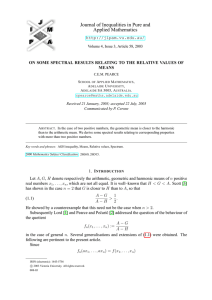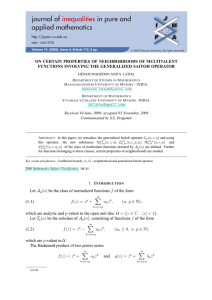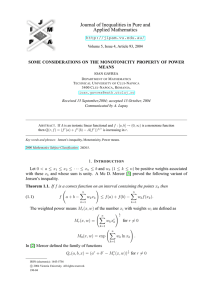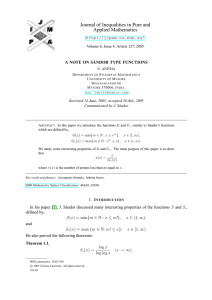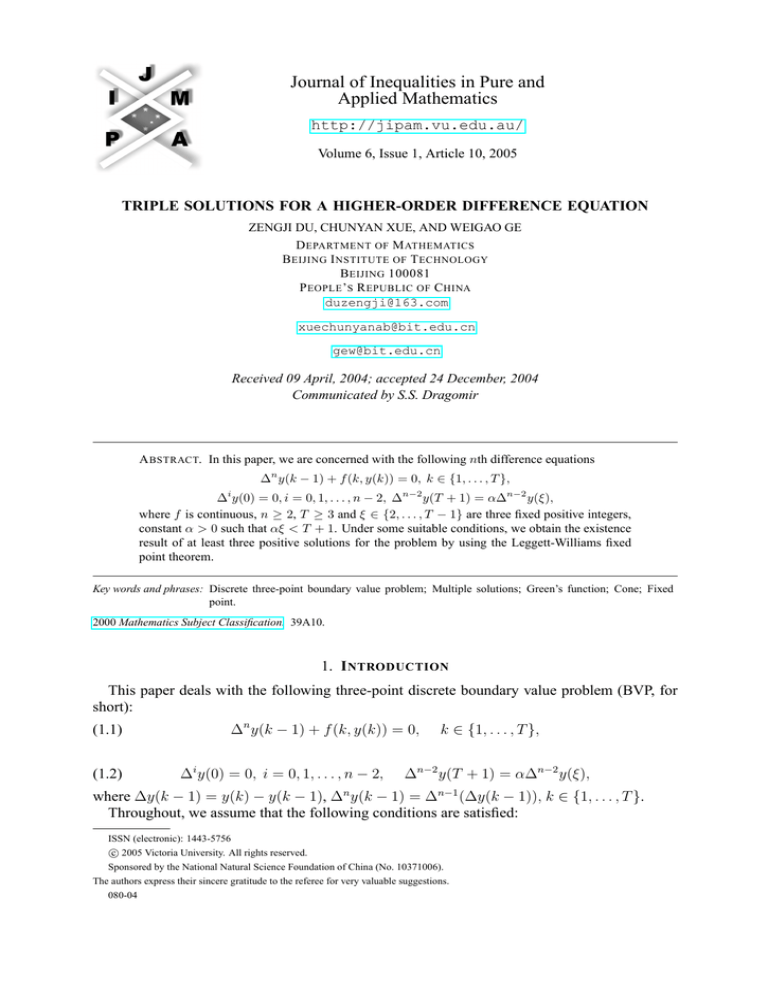
Journal of Inequalities in Pure and
Applied Mathematics
http://jipam.vu.edu.au/
Volume 6, Issue 1, Article 10, 2005
TRIPLE SOLUTIONS FOR A HIGHER-ORDER DIFFERENCE EQUATION
ZENGJI DU, CHUNYAN XUE, AND WEIGAO GE
D EPARTMENT OF M ATHEMATICS
B EIJING I NSTITUTE OF T ECHNOLOGY
B EIJING 100081
P EOPLE ’ S R EPUBLIC OF C HINA
duzengji@163.com
xuechunyanab@bit.edu.cn
gew@bit.edu.cn
Received 09 April, 2004; accepted 24 December, 2004
Communicated by S.S. Dragomir
A BSTRACT. In this paper, we are concerned with the following nth difference equations
∆n y(k − 1) + f (k, y(k)) = 0, k ∈ {1, . . . , T },
∆i y(0) = 0, i = 0, 1, . . . , n − 2, ∆n−2 y(T + 1) = α∆n−2 y(ξ),
where f is continuous, n ≥ 2, T ≥ 3 and ξ ∈ {2, . . . , T − 1} are three fixed positive integers,
constant α > 0 such that αξ < T + 1. Under some suitable conditions, we obtain the existence
result of at least three positive solutions for the problem by using the Leggett-Williams fixed
point theorem.
Key words and phrases: Discrete three-point boundary value problem; Multiple solutions; Green’s function; Cone; Fixed
point.
2000 Mathematics Subject Classification. 39A10.
1. I NTRODUCTION
This paper deals with the following three-point discrete boundary value problem (BVP, for
short):
(1.1)
(1.2)
∆n y(k − 1) + f (k, y(k)) = 0,
∆i y(0) = 0, i = 0, 1, . . . , n − 2,
k ∈ {1, . . . , T },
∆n−2 y(T + 1) = α∆n−2 y(ξ),
where ∆y(k − 1) = y(k) − y(k − 1), ∆n y(k − 1) = ∆n−1 (∆y(k − 1)), k ∈ {1, . . . , T }.
Throughout, we assume that the following conditions are satisfied:
ISSN (electronic): 1443-5756
c 2005 Victoria University. All rights reserved.
Sponsored by the National Natural Science Foundation of China (No. 10371006).
The authors express their sincere gratitude to the referee for very valuable suggestions.
080-04
2
Z ENGJI D U , C HUNYAN X UE ,
AND
W EIGAO G E
(H1 ) T ≥ 3 and ξ ∈ {2, . . . , T − 1} are two fixed positive integers, α > 0 such that αξ <
T + 1.
(H2 ) f ∈ C({1, . . . , T } × [0, +∞), [0, +∞)) and f (k, ·) ≡ 0 does not hold on {1, . . . , ξ − 1}
and {ξ, . . . , T }.
In the few past years, there has been increasing interest in studying the existence of multiple
positive solutions for differential and difference equations, for example, we refer the reader to
[1] – [8].
Recently, Ma [9] studied the following second-order three-point boundary value problem
(1.3)
u00 + λa(t)f (u) = 0, t ∈ (0, 1),
u(0) = 0,
αu(η) = u(1),
by applying fixed-point index theorems and Leray-Schauder degree and upper and lower solutions. In the case λ = 1, under the conditions that f is superlinear or sublinear, Ma [10] considered the existence of at least one positive solution of problem (1.3) by using Krasnosel’skii’s
fixed-point theorem.
However, in [9] – [11], the author did not give the associate Green’s function and exceptional
work was carried out for higher order multi-point difference equations. In the current work, we
give the associate Green’s function and obtain the existence of multiple positive solutions for
BVP (1.1) – (1.2) by employing the Leggett-Williams fixed point theorem. Our results are new
and different from those in [9] – [11]. Particularly, we do not require the assumption that f is
either superlinear or sublinear.
2. BACKGROUND D EFINITIONS AND G REEN ’ S F UNCTION
For the convenience of the reader, we present here the necessary definitions from cone theory
in Banach space, which can be found in [3].
Let N be the nonnegative integers, we let Ni,j = {k ∈ N : i ≤ k ≤ j} and Np = N0,p .
We say that y is a positive solution of BVP (1.1) – (1.2), if y : NT +n−1 −→ R, y satisfies
(1.1) on N1,T , y fulfills (1.2) and y is nonnegative on NT +n−1 and positive on Nn−1,T .
Definition 2.1. Let E be a Banach space, a nonempty closed set K ⊂ E is said to be a cone
provided that
(i) if x ∈ K and λ ≥ 0 then λx ∈ K;
(ii) if x ∈ K and −x ∈ K then x = 0.
If K ⊂ E is a cone, we denote the order induced by K on E by ≤. For x, y ∈ K, we write
x ≤ y if and only if y − x ∈ K.
Definition 2.2. A map h is a nonnegative continuous concave functional on the cone K which
is convex, provided that
(i) h : K −→ [0, ∞) is continuous;
(ii) h(tx + (1 − t)y) ≥ th(x) + (1 − t)h(y) for all x, y ∈ K and 0 ≤ t ≤ 1.
Now we shall denote
Kc = {y ∈ K : kyk < c}
and
K(h, a, b) = {y ∈ K : h(y) ≥ a, kyk ≤ b},
where k · k is the maximum norm.
Next we shall state the fixed point theorem due to Leggett-Williams [12] also see [3].
J. Inequal. Pure and Appl. Math., 6(1) Art. 10, 2005
http://jipam.vu.edu.au/
T RIPLE S OLUTIONS FOR A H IGHER - ORDER D IFFERENCE E QUATION
3
Theorem 2.1. Let E be a Banach space, and let K ⊂ E be a cone in E. Assume that h is a
nonnegative continuous concave functional on K such that h(y) ≤ kyk for all y ∈ Kc , and let
S : Kc −→ Kc be a completely continuous operator. Suppose that there exist 0 < a < b < d ≤
c such that
(A1 ) {y ∈ K(h, b, d) : h(y) > b} =
6 ∅ and h(Sy) > b for all y ∈ K(h, b, d);
(A2 ) kSyk < a for kyk < a;
(A3 ) h(Sy) > b for all y ∈ K(h, b, c) with kSyk > d.
Then S has at least three fixed points y1 , y2 and y3 in Kc such that ky1 k < a, h(y2 ) > b and
ky3 k > a with h(y3 ) < b.
In the following, we assume that the function G(k, l) is the Green’s function of the problem
−∆n y(k − 1) = 0 with the boundary condition (1.2).
It is clear that (see [3])
g(k, l) = ∆n−2 G(k, l), (with respect to k)
is the Green’s function of the problem −∆2 y(k − 1) = 0 with the boundary condition
y(0) = 0,
(2.1)
y(T + 1) = αy(ξ).
We shall give the Green’s function of the problem −∆2 y(k−1) = 0 with the boundary condition
(2.1).
Lemma 2.2. The problem
∆2 y(k − 1) + u(k) = 0,
(2.2)
k ∈ N1,T ,
with the boundary condition (2.1) has the unique solution
k−1
X
(2.3) y(k) = − (k − l)u(l) +
l=1
T
X
k
(T + 1 − l)u(l)
T + 1 − αξ l=1
ξ−1
X
αk
−
(ξ − l)u(l),
T + 1 − αξ l=1
k ∈ NT +1 .
Proof. From (2.2), one has
∆y(k) − ∆y(k − 1) = −u(k),
∆y(k − 1) − ∆y(k − 2) = −u(k − 1),
..
.
∆y(1) − ∆y(0) = −u(1).
We sum the above equalities to obtain
∆y(k) = ∆y(0) −
k
X
u(l),
k ∈ NT ,
l=1
J. Inequal. Pure and Appl. Math., 6(1) Art. 10, 2005
http://jipam.vu.edu.au/
4
Z ENGJI D U , C HUNYAN X UE ,
AND
W EIGAO G E
P
here and in the following, we denote ql=p u(l) = 0, if p > q. Similarly, we sum the equalities
from 0 to k and change the order of summation to obtain
y(k + 1) = y(0) + (k + 1)∆y(0) −
k X
l
X
u(j)
l=1 j=1
= y(0) + (k + 1)∆y(0) −
k
X
(k + 1 − l)u(l),
k ∈ NT ,
l=1
i.e.,
(2.4)
y(k) = y(0) + k∆y(0) −
k−1
X
(k − l)u(l),
k ∈ NT +1 .
l=1
By using the boundary condition (2.1), we have
(2.5)
ξ−1
T
X
X
1
α
∆y(0) =
(T + 1 − l)u(l) −
(ξ − l)u(l).
T + 1 − αξ l=1
T + 1 − αξ l=1
By (2.4) and (2.5), we have shown that (2.3) holds.
Lemma 2.3. The function
(2.6)
g(k, l) =
l[T + 1 − k − α(ξ − k)]
,
T + 1 − αξ
l(T + 1 − k) + αξ(k − l)
,
T + 1 − aξ
k[T + 1 − l − α(ξ − l)]
,
T + 1 − αξ
k(T + 1 − l)
,
T + 1 − αξ
l ∈ N1,k−1
T
N1,ξ−1 ;
l ∈ Nξ,k−1 ;
l ∈ Nk,ξ−1 ;
l ∈ Nk,T
T
Nξ,T .
is the Green’s function of the following problem
(2.7)
−∆2 y(k − 1) = 0, k ∈ N1,T ,
(2.1)
y(0) = 0, y(T + 1) = αy(ξ).
Proof. We shall divide the proof into the following two steps.
Step 1. We suppose k < ξ. Then the unique solution of problem (2.7), (2.1) can be written as
k−1
X
y(k) = − (k − l)u(l) +
l=1
k−1
X
k
(T + 1 − l)u(l)
T + 1 − αξ l=1
" ξ−1
#
T
X
X
k
+
(T + 1 − l)u(l) +
(T + 1 − l)u(l)
T + 1 − αξ l=k
l=ξ
" k−1
#
ξ−1
X
X
αk
−
(ξ − l)u(l) +
(ξ − l)u(l)
T + 1 − αξ l=1
l=k
J. Inequal. Pure and Appl. Math., 6(1) Art. 10, 2005
http://jipam.vu.edu.au/
T RIPLE S OLUTIONS FOR A H IGHER - ORDER D IFFERENCE E QUATION
5
k−1
X
l[T + 1 − k − α(ξ − k)]
=
u(l)
T
+
1
−
αξ
l=1
ξ−1
T
X
X
k[T + 1 − l − α(ξ − l)]
k(T + 1 − l)
+
u(l) +
u(l)
T + 1 − αξ
T + 1 − αξ
l=k
l=ξ
=
T
X
g(k, l)u(l).
l=1
Step 2. We suppose k ≥ ξ. Then the unique solution of problem (2.7), (2.1) can be written as
#
" ξ−1
k−1
X
X
(k − l)u(l)
(k − l)u(l) +
y(k) = −
l=ξ
l=1
k
+
T + 1 − αξ
" ξ−1
X
(T + 1 − l)u(l) +
l=1
k−1
X
(T + 1 − l)u(l) +
T
X
l=ξ
#
(T + 1 − l)u(l)
l=k
ξ−1
X
αk
−
(ξ − l)u(l)
T + 1 − αξ l=1
ξ−1
X
l[T + 1 − k − α(ξ − k)]
=
u(l)
T
+
1
−
αξ
l=1
+
=
T
X
k−1
T
X
X
l(T + 1 − k) + αξ(k − l)
k(T + 1 − l)
u(l) +
u(l)
T
+
1
−
αξ
T
+
1
−
αξ
l=ξ
l=k
g(k, l)u(l).
l=1
Thus the unique solution of problem (2.7), (2.1) can be written as y(k) =
PT
l=1
g(k, l)u(l).
We observe that the condition αξ < T +1 implies that g(k, l) is nonnegative on NT +1 ×N1,T ,
and positive on N1,T × N1,T . From (2.3), we have
y(k) =
T
X
g(k, l)u(l),
l=1
where
g(k, l) := (T +1−αξ)−1 k(T + 1 − l) − (k − l)(T + 1 − αξ)χ[1,k−1] (l) − αk(ξ − l)χ[1,ξ−1] (l) .
This is a positive function, which means that the finite set
{g(k, l)/g(k, k) : k, l = 1, 2, . . . , T }
takes positive values. Let M1 , M2 be its minimum and maximum values, respectively.
3. E XISTENCE OF T RIPLE S OLUTIONS
In the following, we denote
m = min
k∈Nξ,T
T
X
l=ξ
J. Inequal. Pure and Appl. Math., 6(1) Art. 10, 2005
g(k, l),
M = max
k∈NT +1
T
X
g(k, l)
l=1
http://jipam.vu.edu.au/
6
Z ENGJI D U , C HUNYAN X UE ,
AND
W EIGAO G E
and
m
e = min g(k, k),
k∈Nξ,T
f = max g(k, k).
M
k∈NT +1
f.
Then 0 < m < M , 0 < m
e <M
Let E be the Banach space defined by
E = {y : NT +n−1 −→ R, ∆i y(0) = 0, i = 0, 1, . . . , n − 2}.
Define
K=
where σ =
M1 m
e
f
M2 M
n−2
y∈E:∆
n−2
y(k) ≥ 0 for k ∈ NT +1 and min ∆
k∈Nξ,T
y(k) ≥ σkyk
∈ (0, 1), kyk = max |∆n−2 y(k)|. It is clear that K is a cone in E.
k∈NT +1
Finally, let the nonnegative continuous concave functional h : K −→ [0, ∞) be defined by
h(y) = min ∆n−2 y(k),
k∈Nξ,T
y ∈ K.
Note that for y ∈ K, h(y) ≤ kyk.
Remark 3.1. If y ∈ K, kyk ≤ c, then
0 ≤ y(k) ≤ qc,
k ∈ NT +n−1 ,
where
(T + n − 1)(T + n) · · · (T + 2n − 4)
.
(n − 2)!
In fact, if y ∈ K, kyk ≤ c, then 0 ≤ ∆n−2 y(k) ≤ c, k ∈ NT +1 , i.e.,
q = q(n, T ) =
0 ≤ ∆(∆n−3 y(k)) = ∆n−3 y(k + 1) − ∆n−3 y(k) ≤ c.
Then one has
0 ≤ ∆n−3 y(1) − ∆n−3 y(0) ≤ c,
0 ≤ ∆n−3 y(2) − ∆n−3 y(1) ≤ c,
..
.
0 ≤ ∆n−3 y(k) − ∆n−3 y(k − 1) ≤ c.
We sum the above inequalities to obtain
0 ≤ ∆n−3 y(k) ≤ kc,
k ∈ NT +2 .
Similarly, we have
0 ≤ ∆n−4 y(k) ≤
k
X
i=1
!
i c=
k(k + 1)
c,
2!
k ∈ NT +3 .
By using the induction method, one has
k(k + 1) · · · (k + n − 3)
0 ≤ y(k) ≤
c,
k ∈ NT +n−1 .
(n − 2)!
Then
(T + n − 1)(T + n) · · · (T + 2n − 4)
0 ≤ y(k) ≤
c = qc,
k ∈ NT +n−1 .
(n − 2)!
m
Theorem 3.2. Assume that there exist constants a, b, c such that 0 < a < b < c · min σ, M
and satisfy
J. Inequal. Pure and Appl. Math., 6(1) Art. 10, 2005
http://jipam.vu.edu.au/
T RIPLE S OLUTIONS FOR A H IGHER - ORDER D IFFERENCE E QUATION
(H3 ) f (k, y) ≤
(H4 ) f (k, y) <
c
,
M
a
,
M
7
(k, y) ∈ [0, T + n − 1] × [0, qc],
(k, y) ∈ [0, T + n − 1] × [0, qa],
(H5 ) There exists some l0 ∈ [n − 2, T + n − 1], such that f (k, y) ≥
n − 1] × b, qb
, where m0 = min g(k, l) > 0.
σ
b
,
m0
(k, y) ∈ [n − 2, T +
k,l∈NT
Then BVP (1.1) – (1.2) has at least three positive solutions y1 , y2 and y3 , such that
ky1 k < a,
(3.1)
h(y2 ) > b,
and
ky3 k > a
(3.2)
with h(y3 ) < b.
Proof. Let the operator S : K −→ E be defined by
(Sy)(k) =
T
X
k ∈ NT +n−1 .
G(k, l)f (l, y(l)),
l=1
It follows that
(3.3)
n−2
∆
(Sy)(k) =
T
X
g(k, l)f (l, y(l)), for
k ∈ NT +1 .
l=1
We shall now show that the operator S maps K into itself. For this, let y ∈ K, from (H1 ), (H2 ),
one has
T
X
n−2
(3.4)
∆ (Sy)(k) =
g(k, l)f (l, y(l)) ≥ 0, for
k ∈ NT +1 ,
l=1
and
∆n−2 (Sy)(k) =
T
X
g(k, l)f (l, y(l))
l=1
≤ M2
T
X
g(k, k)f (l, y(l))
l=1
f
≤ M2 M
T
X
f (l, y(l)),
for
k ∈ NT +1 .
l=1
Thus
f
kSyk ≤ M2 M
T
X
f (l, y(l)).
l=1
From (H1 ), (H2 ), and (3.3), for k ∈ Nξ,T , we have
∆n−2 (Sy)(k) ≥ M1
T
X
g(k, k)f (l, y(l))
l=1
≥ M1 m
e
T
X
l=1
f (l, y(l)) ≥
M1 m
e
kSyk = σkSyk.
f
M2 M
Subsequently
(3.5)
min ∆n−2 (Sy)(k) ≥ σkSyk.
k∈Nξ,T
J. Inequal. Pure and Appl. Math., 6(1) Art. 10, 2005
http://jipam.vu.edu.au/
8
Z ENGJI D U , C HUNYAN X UE ,
AND
W EIGAO G E
From (3.4) and (3.5), we obtain Sy ∈ K. Hence S(K) ⊆ K. Also standard arguments yield
that S : K −→ K is completely continuous.
We now show that all of the conditions of Theorem 2.1 are fulfilled. For all y ∈ Kc , we have
kyk ≤ c. From assumption (H3 ), we get
kSyk = max |∆n−2 (Sy)(k)|
k∈NT +1
T
X
= max g(k, l)f (l, y(l))
k∈NT +1 l=1
T
X
c
max
g(k, l) = c.
≤
M k∈NT +1 l=1
Hence S : Kc −→ Kc .
Similarly, if y ∈ Ka , then assumption (H4 ) yields f (k, y) < Ma , for k ∈ NT +1 . As in the
argument above, we can show S : Ka −→ Ka . Therefore, condition (A2 ) of Theorem 2.1 is
satisfied.
Now we prove that condition (A1 ) of Theorem 2.1 holds. Let
k(k + 1) · · · (k + n − 3)b
, for
k ∈ Nξ,T .
(n − 2)!σ
Then we can show that y ∗ ∈ K h, b, qb
and h(y ∗ ) ≥ σb > b. So
σ
b
: h(y) > b 6= ∅.
y ∈ K h, b,
σ
y ∗ (k) =
From assumptions (H2 ) and (H5 ), one has
h(Sy) = min
k∈Nξ,T
> min
k∈Nξ,T
T
X
g(k, l)f (l, y(l))
l=1
T
X
g(k, l)f (l, y(l))
l=ξ
≥ min g(k, l0 )f (l0 , y(l0 ))
k∈Nξ,T
≥
b
min g(k, l) ≥ b.
m0 k∈Nξ,T
This shows that condition (A1 ) of Theorem 2.1 is satisfied.
Finally, suppose that y ∈ K(h, b, c) with kSyk > σb , then
h(Sy) = min ∆n−2 (Sy)(k) ≥ σkSyk > b.
k∈Nξ,T
Thus, condition (A3 ) of Theorem 2.1 is also satisfied. Therefore, Theorem 2.1 implies that BVP
(1.1) – (1.2) has at least three positive solutions y1 , y2 , y3 described by (3.1) and (3.2).
Corollary 3.3. Suppose that there exist constants
n mo
n mo
0 < a1 < b1 < c1 · min σ,
< a2 < b2 < c2 · min σ,
< · · · < ap ,
M
M
p is a positive integer, such that the following conditions are satisfied:
ai
, (k, y) ∈ [0, T + n − 1] × [0, qai ], i ∈ N1,p ;
(H7 ) f (k, y) < M
J. Inequal. Pure and Appl. Math., 6(1) Art. 10, 2005
http://jipam.vu.edu.au/
T RIPLE S OLUTIONS FOR A H IGHER - ORDER D IFFERENCE E QUATION
(H8 ) There exist li0 ∈ [n − 2, T + n − 1], such that f (k, y) ≥
1] × [bi , qbσi ], i ∈ N1,p−1 .
Then BVP (1.1) – (1.2) has at least 2p − 1 positive solutions.
qbi
,
m0
9
(k, y) ∈ [n − 2, T + n −
Proof. When p = 1, from condition (H7 ), we show S : Ka1 −→ Ka1 ⊆ Ka1 . By using
the Schauder fixed point theorem, we show that BVP (1.1) – (1.2) has at least one fixed point
y1 ∈ Ka1 . When p = 2, it is clear that Theorem 3.2 holds ( with c1 = a2 ). Then we can
obtain BVP (1.1) – (1.2) has at least three positive solutions y1 , y2 and y3 , such that ky1 k < a1 ,
h(y2 ) > b1 , ky3 k > a1 , with h(y3 ) < b1 . Following this way, we finish the proof by the
induction method. The proof is completed.
If the case n = 2, similar to the proof of Theorem 3.2, we obtain the following result.
m
Corollary 3.4. Assume that there exist constants a, b, c such that 0 < a < b < c · min σ, M
and satisfy
(H9 ) f (k, y) ≤ Mc , (k, y) ∈ [0, T + n − 1] × [0, c],
(H10 ) f (k, y) <
a
,
M
(k, y) ∈ [0, T + n − 1] × [0, a],
(H11 ) f (k, y) ≥ mb , (k, y) ∈ [ξ, T + n − 1] × [b, σb ].
Then BVP (1.1) – (1.2) has at least three positive solutions y1 , y2 and y3 , satisfying (3.1) and
(3.2).
Finally, we give an example to illustrate our main result.
Example 3.1. Consider the following second order third point boundary value problem
(3.6)
∆2 y(k − 1) + f (k, y) = 0,
y(0) = 0,
(3.7)
where f (k, y) =
k ∈ N1,6 ,
7
y(7) = y(3),
9
100
a(y),
k+100
and
1
1
8
+ sin y,
if y ∈ 0,
;
720
30
1
1 1
+6 y−
+ sin8 y,
if y ∈ 30
,3 ;
a(y) =
720
30
2
1 + 89 + sin (y − 3) + sin8 y, if y ∈ [3, 360].
720
5
2
7
Then T = 6, n = 3, α = 9 < 1, T + 1 − αn = 14
> 0. Then the conditions (H1 ), (H2 ) are
3
satisfied, and the function
T
l(42 − 2k)
,
l ∈ N1,k−1 N1,2 ;
9
3l(7 − k) + 7(k − l)
, l ∈ N3,k−1 ;
3
3
G(k, l) =
14
k(42 − 2l)
,
l ∈ Nk,2 ;
9
T
k(7 − l),
l ∈ Nk,6 N3,6 ,
is the Green’s function of the problem −∆2 y(k − 1) = 0, k ∈ N1,6 with (3.7).
J. Inequal. Pure and Appl. Math., 6(1) Art. 10, 2005
http://jipam.vu.edu.au/
10
Z ENGJI D U , C HUNYAN X UE ,
AND
W EIGAO G E
f = 18 , M1 = 2 , M2 = 9, σ =
Thus we can compute m = 27
, M = 18, m
e = 97 , M
2
7
9
3
1
1
. We choose that a = 35
, b = 10
, c = 360, consequently,
4
1
81
<
m
M
=
100
a(y)
k + 100
1
c
1
+ 1 < 20 =
,
(k, y) ∈ [0, 7] × 0, 30
;
720
M
1 1
1
c
≤ a(y) ≤
+6 3−
+ 1 < 20 =
, (k, y) ∈ [0, 7] × 30
,3 ;
720
30
M
1 + 89 + 3 < 20 = c ,
(k, y) ∈ [0, 7] × [3, 360].
M
720
5
2
f (k, y) =
Thus
f (k, y) ≤
c
,
M
(k, y) ∈ [0, 7] × [0, 360];
and
1
1
a
1
8
f (k, y) ≤
+ sin y <
=
,
(k, y) ∈ [0, 7] × 0,
;
720
630
M
35
100 1
1
1
1
b
1
8
f (k, y) ≥
+6
−
+ sin y ≥
= ,
(k, y) ∈ [3, 7] ×
,3 .
107 720
10 30
135
m
27
That is to say, all the conditions of Corollary 3.4 are satisfied. Then the boundary value problem
(3.6), (3.7) has at least three positive solutions y1 , y2 and y3 , such that
1
1
y1 (k) < , for k ∈ N7 , y2 (k) > , for k ∈ N3,7 ,
35
27
and
1
1
max y3 (k) > , for k ∈ N7 with min y3 (k) < .
k∈N1,7
k∈N3,7
35
27
R EFERENCES
[1] X.M. HE AND W.G. GE, Triple solutions for second order three-point boundary value problems, J.
Math. Anal. Appl., 268 (2002), 256–265.
[2] Y.P. GUO, W.G. GE AND Y. GAO, Two Positive solutions for higher-order m-point boundary value
problems with sign changing nonlinearities, Appl. Math. Comput., 146 (2003), 299–311.
[3] R.P. AGARWAL, D. O’REGAN AND P.J.Y. WONG, Positive Solutions of Differential, Difference
and Integral Equations, Kluwer Academic Publishers, Boston, 1999.
[4] G.L. KARAKOSTAS, K.G. MAVRIDIS AND P.Ch. TSAMATOS, Multiple positive solutions for a
functional second order boundary value problem, J. Math. Anal. Appl., 282 (2003), 567–577.
[5] H.B. THOMPSON, Existence of multiple solutions for finite difference approximations to secondorder boundary value problems, Nonlinear Anal., 53 (2003), 97–110.
[6] R.M. ABU-SARIS AND Q.M. AL-HASSAN, On global periodicity of difference equations, J.
Math. Anal. Appl., 283 (2003), 468–477.
[7] Z.J. DU, W.G. GE AND X.J. LIN, Existence of solution for a class of third order nonlinear boundary
value problems, J. Math. Anal. Appl., 294 (2004), 104–112.
[8] A. CABADA, Extremal solutions for the difference p-Laplacian problem with nonlinear functional
boundary conditions, Comput. Math. Appl., 42 (2001), 593–601.
[9] R.Y. MA, Multiplicity of positive solutions for second order three-point boundary value problems,
Comput. Math. Appl., 40 (2000), 193–204.
J. Inequal. Pure and Appl. Math., 6(1) Art. 10, 2005
http://jipam.vu.edu.au/
T RIPLE S OLUTIONS FOR A H IGHER - ORDER D IFFERENCE E QUATION
11
[10] R.Y. MA, Positive solutions of a nonlinear three-point boundary value problems, Electron J. Differential Equations, 34 (1999), 1–8.
[11] R.Y. MA, Positive solutions for second order three-point boundary value problems, Appl. Math.
Lett., 14 (2001), 1–5.
[12] R.W. LEGGETT AND L.R. WILLIAMS, Multiple positive fixed points of nonlinear operators on
ordered Banach spaces, Indiana Univ. Math. J., 28 (1979), 673–688.
J. Inequal. Pure and Appl. Math., 6(1) Art. 10, 2005
http://jipam.vu.edu.au/


